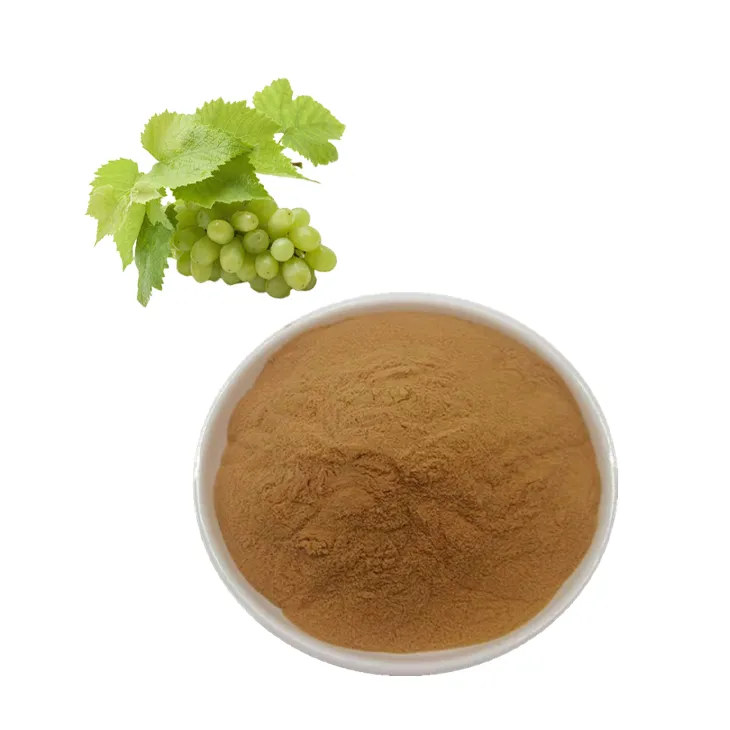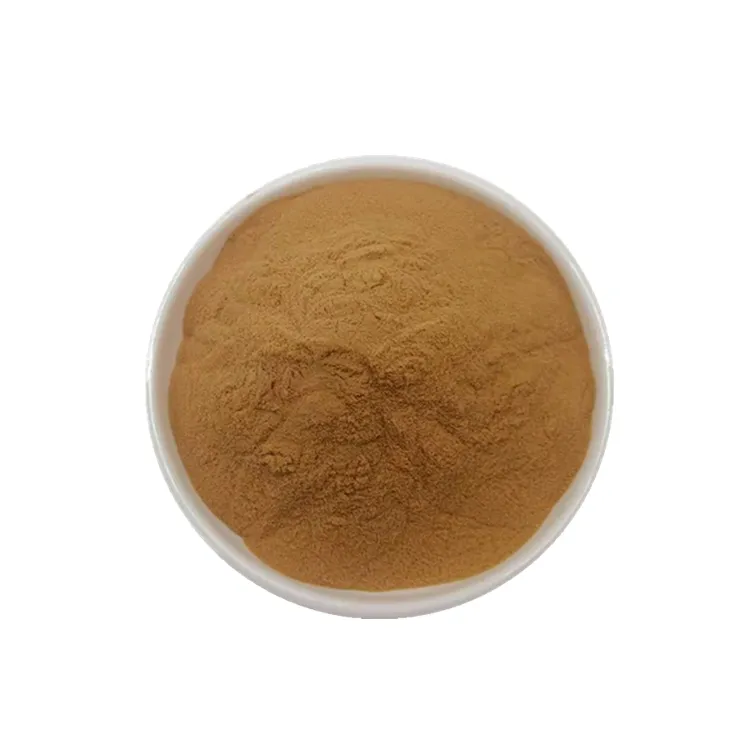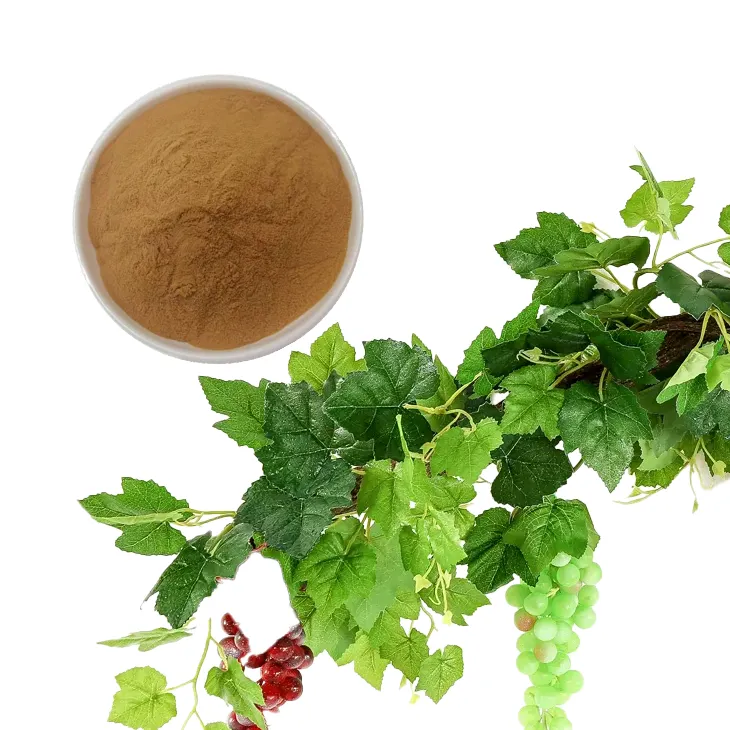- 0086-571-85302990
- sales@greenskybio.com
The process of extracting grape leaf polyphenols from grape leaf extracts.
2024-11-29

1. Introduction
Grape Leaf Extract is a rich source of various bioactive compounds, and among them, grape leaf polyphenols have attracted significant attention. These polyphenols are known for their potential health - promoting properties, which make their extraction not only important for scientific research but also crucial for the development of products in the healthcare and nutraceutical industries. Understanding the process of extracting grape leaf polyphenols from Grape Leaf Extracts is, therefore, a topic of great interest.

2. Pretreatment of Grape Leaf Extract
The first step in the extraction process of grape leaf polyphenols is the pretreatment of the grape leaf extract. This step is essential as it helps to optimize the conditions for polyphenol extraction.
2.1. Sample Preparation
The grape leaves need to be carefully collected and cleaned to remove any dirt, debris, or contaminants. Once cleaned, they can be dried using appropriate methods such as air - drying or low - temperature drying. Drying helps to preserve the bioactive compounds present in the leaves. After drying, the leaves are usually ground into a fine powder. This increases the surface area of the sample, which in turn enhances the extraction efficiency.
2.2. Solvent Selection for Pretreatment
The choice of solvent for pretreatment also plays a crucial role. A solvent should be selected that can effectively dissolve the components in the grape leaf extract and at the same time not cause degradation of the polyphenols. Commonly used solvents for pretreatment include water, ethanol, or a mixture of both. Water is a natural and environmentally friendly solvent, while ethanol has good solubility for many bioactive compounds. The solvent - to - sample ratio also needs to be carefully determined. A too - high or too - low ratio can affect the extraction yield. For example, a very high solvent - to - sample ratio may lead to dilution of the polyphenols, while a very low ratio may not be sufficient to dissolve all the target compounds.

3. Conventional Extraction Methods
Conventional extraction methods have been widely used for the extraction of grape leaf polyphenols from grape leaf extracts. One of the most well - known methods is the Soxhlet extraction.
3.1. Soxhlet Extraction
Soxhlet extraction is a continuous extraction method that uses a solvent. The principle behind Soxhlet extraction is that the solvent is continuously recycled through the sample. The grape leaf extract, usually in the form of a powder, is placed in a Soxhlet thimble. The solvent, such as ethanol or a mixture of ethanol and water, is heated in a flask. As the solvent vaporizes, it rises up and condenses in a condenser. The condensed solvent then drips onto the sample in the thimble and extracts the polyphenols. The solvent, now containing the extracted polyphenols, then drains back into the flask. This process is repeated continuously for a certain period of time, usually several hours. One of the advantages of Soxhlet extraction is that it can achieve a relatively high extraction yield. However, it also has some drawbacks. For example, it requires a relatively large amount of solvent, which can be costly and may also pose environmental concerns. Additionally, the long extraction time may lead to degradation of some heat - sensitive polyphenols.

4. New Extraction Technologies
In recent years, new extraction technologies have been explored for the extraction of grape leaf polyphenols. One such technology is supercritical fluid extraction.
4.1. Supercritical Fluid Extraction
Supercritical fluid extraction (SFE) offers several advantages over conventional extraction methods. A supercritical fluid is a substance that is above its critical temperature and critical pressure. For example, carbon dioxide (CO₂) is a commonly used supercritical fluid in extraction processes. In SFE, the supercritical CO₂ has properties that are intermediate between a gas and a liquid. It has a high diffusivity like a gas, which allows it to penetrate the sample quickly, and at the same time, it has a density similar to a liquid, which enables it to dissolve the target compounds effectively. One of the major advantages of SFE is the reduced solvent usage. Since CO₂ is a gas at normal conditions, it can be easily removed from the extract after extraction, leaving behind a relatively pure product. Another advantage is the higher selectivity. By adjusting the pressure and temperature conditions, it is possible to selectively extract different polyphenols. However, SFE also has some limitations. The equipment for SFE is relatively expensive, and the process requires precise control of pressure and temperature conditions.
5. Separation and Purification
After the extraction of grape leaf polyphenols, separation and purification are carried out to ensure high - quality products.
5.1. Filtration
The first step in separation is often filtration. The extract obtained from the extraction process may contain solid particles, such as plant debris or undissolved components. Filtration can be carried out using various methods, such as vacuum filtration or membrane filtration. Vacuum filtration uses a vacuum pump to create a pressure difference, which forces the liquid extract through a filter paper or a filter membrane. Membrane filtration, on the other hand, uses a semi - permeable membrane with a specific pore size to separate the particles from the liquid. Filtration helps to remove the unwanted solid components and obtain a relatively clear extract.
5.2. Chromatographic Separation
Chromatographic methods are widely used for the purification of grape leaf polyphenols. One of the most common chromatographic techniques is high - performance liquid chromatography (HPLC). In HPLC, the extract is injected into a column filled with a stationary phase. A mobile phase, usually a solvent or a mixture of solvents, is pumped through the column at a constant flow rate. The different polyphenols in the extract have different affinities for the stationary and mobile phases, and thus they are separated as they move through the column. HPLC can achieve high - resolution separation of different polyphenols, allowing for the isolation of individual components. Another chromatographic technique is gas chromatography (GC), which is mainly used for the analysis of volatile polyphenols. However, GC requires the conversion of the sample into a volatile form before analysis.
6. Analytical Methods for Polyphenol Determination
After separation and purification, analytical methods are used to determine the polyphenol content and their chemical composition.
6.1. Spectroscopic Methods
Spectroscopic methods are commonly used for the analysis of polyphenols. One such method is ultraviolet - visible (UV - Vis) spectroscopy. Polyphenols have characteristic absorption bands in the UV - Vis region. By measuring the absorbance of the sample at specific wavelengths, it is possible to estimate the total polyphenol content. Another spectroscopic method is fluorescence spectroscopy. Some polyphenols exhibit fluorescence, and by measuring the fluorescence intensity, information about the polyphenols can be obtained. Infrared (IR) spectroscopy can also be used to analyze the functional groups present in the polyphenols.
6.2. Mass Spectrometry
Mass spectrometry (MS) is a powerful tool for the determination of the chemical composition of polyphenols. In MS, the sample is ionized, and the resulting ions are separated according to their mass - to - charge ratio (m/z). The mass spectrum obtained can provide information about the molecular weight and the fragmentation pattern of the polyphenols. By comparing the mass spectra with known standards, the identity of the polyphenols can be determined. Coupling mass spectrometry with chromatographic techniques, such as HPLC - MS or GC - MS, can provide more detailed information about the polyphenols in the grape leaf extract.
7. Conclusion
The extraction of grape leaf polyphenols from grape leaf extracts is a complex process that involves multiple steps, from pretreatment to extraction, separation, purification, and finally analysis. Conventional extraction methods such as Soxhlet extraction are still widely used, but new extraction technologies like supercritical fluid extraction offer potential advantages in terms of solvent usage and selectivity. Separation and purification steps are crucial for obtaining high - quality polyphenols, and various analytical methods are available to determine the polyphenol content and chemical composition. The study of grape leaf polyphenol extraction is not only important for basic scientific research but also has significant implications for the development of healthcare and nutraceutical products.
FAQ:
What are the initial steps in the extraction process of grape leaf polyphenols?
The initial steps in the extraction process of grape leaf polyphenols include pre - treatment of the grape leaf extract to optimize conditions for polyphenol extraction.
What are the common conventional extraction methods for grape leaf polyphenols?
One of the common conventional extraction methods for grape leaf polyphenols is Soxhlet extraction. It allows for continuous extraction with a solvent.
What are the advantages of new extraction technologies like supercritical fluid extraction?
New extraction technologies like supercritical fluid extraction offer advantages such as reduced solvent usage and higher selectivity in the extraction of grape leaf polyphenols.
Why are separation and purification carried out after extraction?
Separation and purification are carried out after extraction to ensure high - quality grape leaf polyphenols.
Why is the extraction of grape leaf polyphenols important?
The extraction of grape leaf polyphenols is important not only for scientific research but also for the development of products in the health - care and nutraceutical industries due to the potential health - promoting properties of these polyphenols.
Related literature
- Polyphenols from Grape Leaves: Extraction, Identification and Biological Activity"
- "Grape Leaf Polyphenols: Novel Sources and Extraction Techniques for Functional Food Applications"
- "Optimization of Grape Leaf Polyphenol Extraction: A Review of Current Methods"
- ▶ Hesperidin
- ▶ Citrus Bioflavonoids
- ▶ Plant Extract
- ▶ lycopene
- ▶ Diosmin
- ▶ Grape seed extract
- ▶ Sea buckthorn Juice Powder
- ▶ Fruit Juice Powder
- ▶ Hops Extract
- ▶ Artichoke Extract
- ▶ Mushroom extract
- ▶ Astaxanthin
- ▶ Green Tea Extract
- ▶ Curcumin
- ▶ Horse Chestnut Extract
- ▶ Other Product
- ▶ Boswellia Serrata Extract
- ▶ Resveratrol
- ▶ Marigold Extract
- ▶ Grape Leaf Extract
- ▶ New Product
- ▶ Aminolevulinic acid
- ▶ Cranberry Extract
- ▶ Red Yeast Rice
- ▶ Red Wine Extract
-
Green Tea Extract
2024-11-29
-
Sophora Japonica Flower Extract
2024-11-29
-
Polygonum multiflorum extract
2024-11-29
-
Rosemary extract
2024-11-29
-
White Willow Bark Extract
2024-11-29
-
Red Date Extract
2024-11-29
-
Pomegranate Extract
2024-11-29
-
Withania Somnifera Extract
2024-11-29
-
Lemon Balm Extract
2024-11-29
-
Konjac Powder
2024-11-29





















